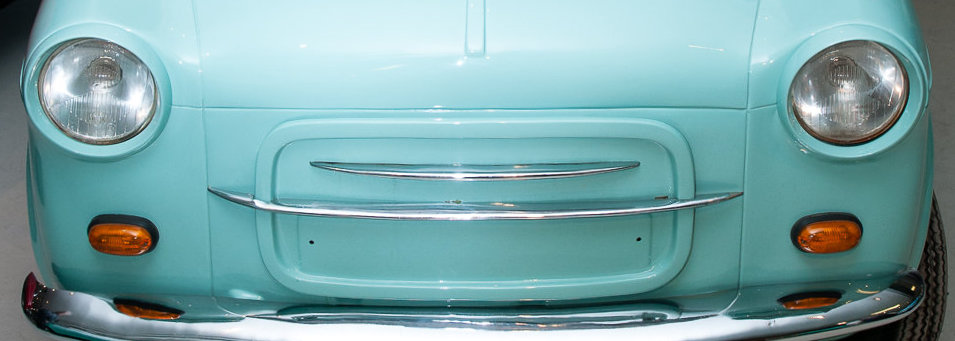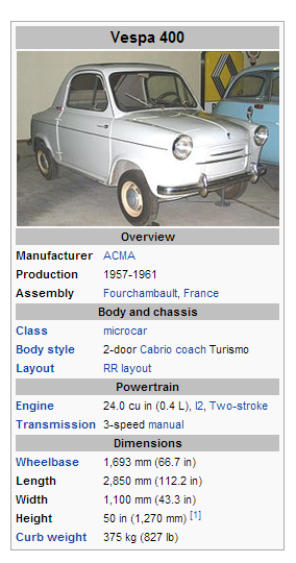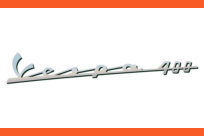




Designed by Ateliers de construction de motocycles et d'automobiles

Vespa 400 - 1959
The Vespa 400 is a rear-engined microcar, produced by
ACMA (Ateliers de construction de motocycles et
d'automobiles) in Fourchambault, France, from 1957 to
1961 to the designs of the Italian Piaggio company. Two
different versions were sold, "Lusso" and "Turismo".
Celebrity launch
The car made its public debut on 26 September 1957 at a press presentation staged in Monaco. The ACMA directors ensured a good attendance from members of the press by also inviting three celebrity racing divers to the Vespa 400 launch.The car
The 400 was a two seater with room behind the seats to accommodate luggage or two small children on an optional cushion. The front seats were simple tubular metal frames with cloth upholstery on elastic "springs" and between the seats were the handbrake, starter and choke. The gear change was centrally floor mounted. The rear hinged doors were coated on the inside with only a thin plastic lining attached to the metal door panel skin allowing valuable extra internal space. On the early cars the main door windows did not open which attracted criticism, but increased the usable width for the driver and passenger. Instrumentation was very basic with only a speedometer and warning lights for low fuel, main beam, dynamo charging and indicators. The cabriolet fabric roof could be rolled back from the windscreen header rail to the top of the rear engine cover leaving conventional metal sides above the doors. The 12 volt battery was located at the front of the car, behind the dummy front grill, on a shelf that could be slid out. The spare wheel was stowed in a well under the passenger seat.Commercial
The high profile launch paid off, with 12,130 cars produced in 1958. That turned out to be the high point, however, and output fell to 8,717 in 1959 despite a price reduction for the entry level 2-seater "normal" coupé from 345,000 francs to 319,500 francs between October 1957 and October 1958. Commentators suggested that the chic image created at the time of the launch was not always matched by the car itself, with its awkward gear change, poor sound-proofing and, especially before a modification to the carburetor specification, high fuel consumption. The car's origins, developed by a leading producer of motor scooters, was reflected in the installation, in the Vespa 400, of a two stroke (motorbike style) engine which required oil to be added to the petrol/gasoline whenever the car was refueled. During the summer of 1958 the cars were fitted with a semi-automatic device for adding oil to the fuel, but a fully automatic fuel mixing device was not included until two years later.Road test
The British Motor magazine tested a 400 de luxe saloon in 1959 recording a top speed of 51.8 mph (83.4 km/h) and acceleration from 0-40 mph (64 km/h) in 23.0 seconds and a fuel consumption of 55.3 miles per imperial gallon (5.11 L/100 km; 46.0 mpg-US). The test car cost 351,725 "old" French Francs, usefully cheaper than the 374,000 "old" French Francs domestic market starting price quoted towards the end of 1958 for the cheapest version of the larger but (even) less powerful Citroen 2CV.Specifications
Engine Two cylinder, two stroke, air cooled. Bore, stroke: 63 mm x 63 mm (393 cc). Motor cyclists at the time were used to mixing oil into their fuel, but the manufacturer belatedly realised that this might compromise the 400's standing as a "car", and from the summer of 1958 "two stroke oil" was held in separate reservoir with a semi-automatic dispenser on the right side of the engine bay. Compression ratio 6.4:1 with 12 hp, later increased respectively to 6.6:1 and 14 hp. Suspension Four wheel independent. Four double acting hydraulic shock absorbers with coil springs. Front anti-roll bar. Manual transmission 3 speed plus reverse, with 2nd & 3rd synchromesh. 4 speed available in non-U.S. markets. Brakes Hydraulically operated drums of 6.75 in (171 mm) diameter. Performance With only 18 hp (13 kW), top speed is 50 to 55 mph (80 to 90 km/h), depending on road grade, wind conditions, etc. Achieving top speed takes a leisurely 25 seconds. Fuel economy is about 5L/100KM.
1959
Engine 393 cc 2 cylinders Power 14 HP Top speed 90 km/h Lenght/width 2,85 m/1,27 m Weight 360 kg The collections Vespa 400 was bought from Italy.
Photos mainly by Matti Kreivilä. Historical facts and technical details of the vehicles provided by Wikipedia. Movies YouTube.



- Autobianchi Transformable - 1960
- Autobianchi Familiare - 1962
- Autobianchi Panoramica - 1962
- Autobianchi Cabriolet - 1963
- BMW Isetta 300 - 1956
- BMW Isetta 300 - 1959
- BMW Isetta Standard
- BMW 600 - 1959
- Bond Bug ES 700 - 1973
- Fiat Topolino - 1936
- Fiat Topolino - 1939
- Fiat Topolino - 1951
- Fiat Belvedere - 1952
- Fiat Topolino - 1954
- Fiat 600 - 1955
- Fiat 500 - 1963
- Fiat 500 - 1969
- Fiat Multipla - 1965
- Fuldamobil 4-wheel - 1958
- Fuldamobil King S7 - 1959
- GLAS Isar T700 - 1962
- Goggomobil T400 - 1959
- Goggomobil T250 - 1961
- Goggomobil T250 - 1969
- Goggomobil Coupe
- Heinkel Kabine - 1959
- Honda N600 - 1970
- Jalta Saporoshez - 1967
- Lloyd Alexander TS - 1960
- Messerschmitt KR200 - 1960
- Messerschmitt KR201
- Messerschmitt KR200 - 1963
- Messerschmitt KR200 - 1964
- NSU Prinz I - 1958
- Scootacar Mk3 - 1963
- Steyr-Puch 500 -1961
- Steyr-Puch 650 - 1964
- Trabant P 50 - 1961
- Trojan 603/198 - 1964
- Trojan 3-wheeler - 1964
- Trojan 3-wheeler - 1964
- Vespa 400 - 1959
- Victoria Spatz 250 - 1957
- ZŁndapp Janus - 1959


- About Scooters
- Apollo moped
- Cezeta 175 - 1960
- Heinkel Tourist - 1960
- Lambretta 125 - 1953
- Puch SR 150 - 1958
- Pyrkijš moped
- Suzuki Burgman 400
- Tunturi City - 1980
- Vespa 150 - 1959
- Yamaha Passola 50 - 1980
- ZŁndapp Bella w. sidecar - 1960
- ZŁndapp Bella 204 - 1960
- ZŁndapp Bella 200 Deluxe - 1963
- ZŁndapp Combinette




















